Critical Evaluation of the Burj Khalifa Project (INF70005 Assignment)
VerifiedAdded on 2023/06/08
|10
|3128
|156
Report
AI Summary
This report provides a critical evaluation of the Burj Khalifa project, assessing its success or failure based on four key criteria: time, cost, quality, and stakeholder benefits. The introduction establishes the project's context and significance within project management, while the discussion section...
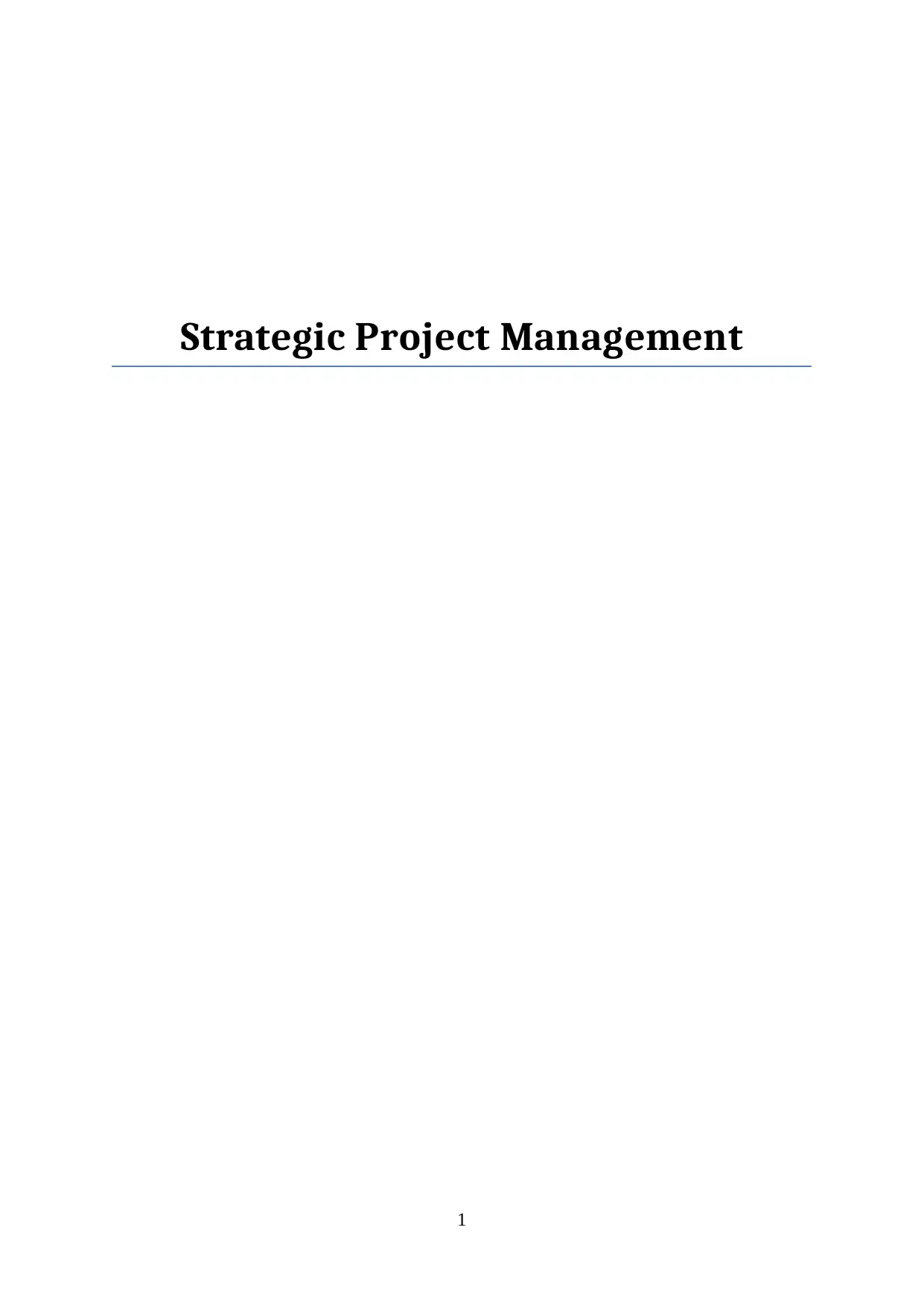
Strategic Project Management
1
1
Paraphrase This Document
Need a fresh take? Get an instant paraphrase of this document with our AI Paraphraser
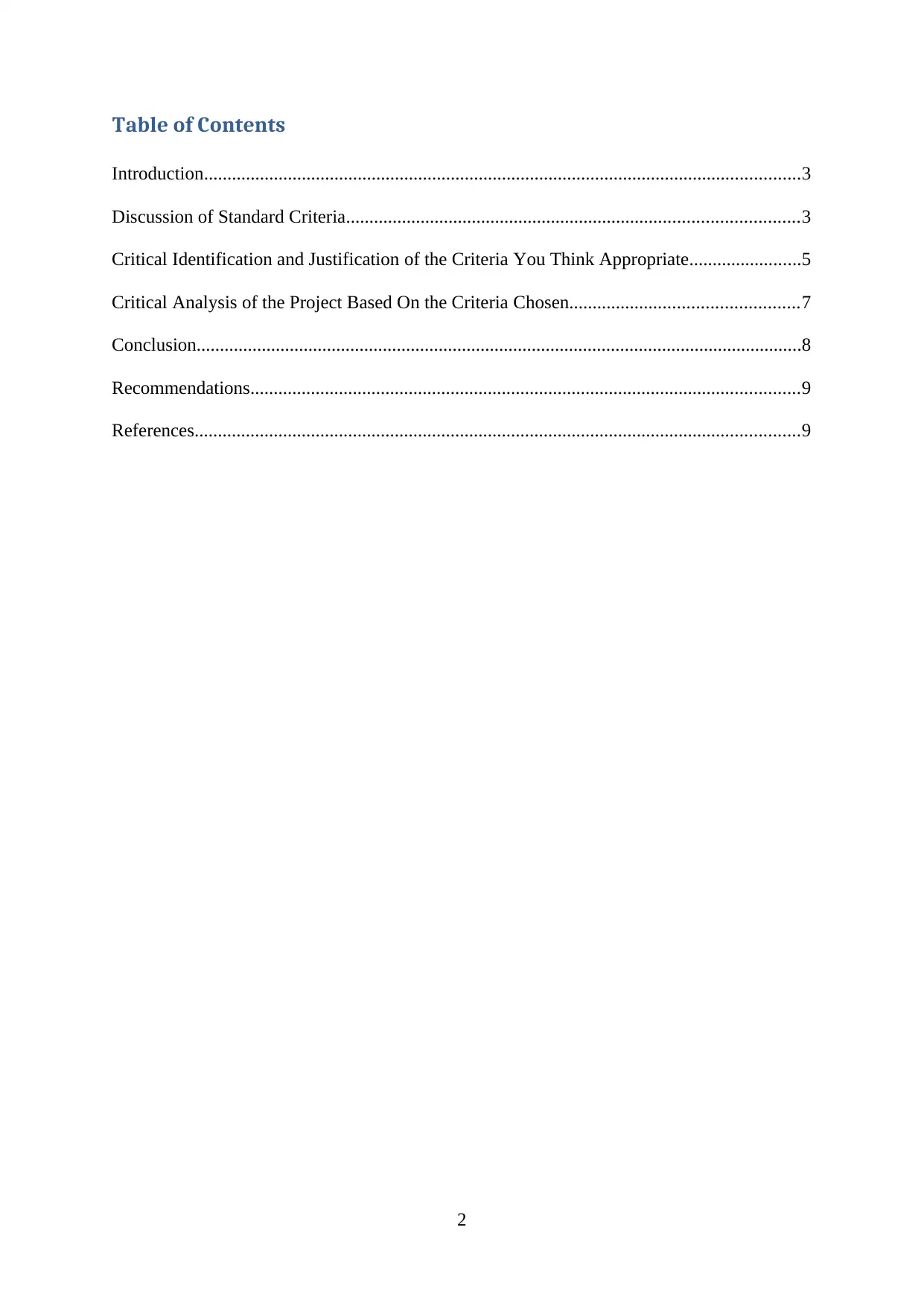
Table of Contents
Introduction................................................................................................................................3
Discussion of Standard Criteria.................................................................................................3
Critical Identification and Justification of the Criteria You Think Appropriate........................5
Critical Analysis of the Project Based On the Criteria Chosen.................................................7
Conclusion..................................................................................................................................8
Recommendations......................................................................................................................9
References..................................................................................................................................9
2
Introduction................................................................................................................................3
Discussion of Standard Criteria.................................................................................................3
Critical Identification and Justification of the Criteria You Think Appropriate........................5
Critical Analysis of the Project Based On the Criteria Chosen.................................................7
Conclusion..................................................................................................................................8
Recommendations......................................................................................................................9
References..................................................................................................................................9
2

Introduction
The Burj Khalifa Dubai project is one of the multiuse towers with a total floor area of
460,000 square meters. The Burj Khalifa includes commercial offices, parking facilities,
shopping and leisure facilities etc. The Burj Khalifa is the centre piece of the overall
development of Dubai. The height of the building exceeds 700 meters, and consists of 160
floors. The Burj Khalifa is located in the heart of Dubai city and the Burj Khalifa was one of
the parts of the Downtown Dubai or Burj Downtown. `The design of the building has been
adopted from the geometry of a desert flower. The Burj Khalifa is the tallest man made
structure on earth. It is one of the biggest achievements of engineering history with over 25
awards and 17 records to its name (Burj Khalifa, 2016). The Burj Khalifa project is one of the
important projects that is studied in the area of project management. This particular paper
will focus on determining whether the Burj Khalifa a success or a failure? There are different
views regarding this question. Therefore this paper will focus on determining whether the
Burj Khalifa is a success or failure with the help of four major project management criteria
that will be identified with the help of the literature. The criteria identified will help in
determining if the Burj Khalifa is a successful or a failed project.
There are differences between the factors or criteria that are used for identifying if a project is
a success or a failure. According to the Cambridge Advanced dictionary, learner criterion can
be defined as the standard that can be used for judging. A factor on the other hand can be
considered as the situation or fact that can have an influence on some aspects. The success or
failure can be judged differently based on their criteria and purpose.
Discussion of Standard Criteria
Bowen et al. (2012) conducted a study on quality, time and cost management. The authors
indicate that these three factors can be used, as the criteria in the project management these
3
The Burj Khalifa Dubai project is one of the multiuse towers with a total floor area of
460,000 square meters. The Burj Khalifa includes commercial offices, parking facilities,
shopping and leisure facilities etc. The Burj Khalifa is the centre piece of the overall
development of Dubai. The height of the building exceeds 700 meters, and consists of 160
floors. The Burj Khalifa is located in the heart of Dubai city and the Burj Khalifa was one of
the parts of the Downtown Dubai or Burj Downtown. `The design of the building has been
adopted from the geometry of a desert flower. The Burj Khalifa is the tallest man made
structure on earth. It is one of the biggest achievements of engineering history with over 25
awards and 17 records to its name (Burj Khalifa, 2016). The Burj Khalifa project is one of the
important projects that is studied in the area of project management. This particular paper
will focus on determining whether the Burj Khalifa a success or a failure? There are different
views regarding this question. Therefore this paper will focus on determining whether the
Burj Khalifa is a success or failure with the help of four major project management criteria
that will be identified with the help of the literature. The criteria identified will help in
determining if the Burj Khalifa is a successful or a failed project.
There are differences between the factors or criteria that are used for identifying if a project is
a success or a failure. According to the Cambridge Advanced dictionary, learner criterion can
be defined as the standard that can be used for judging. A factor on the other hand can be
considered as the situation or fact that can have an influence on some aspects. The success or
failure can be judged differently based on their criteria and purpose.
Discussion of Standard Criteria
Bowen et al. (2012) conducted a study on quality, time and cost management. The authors
indicate that these three factors can be used, as the criteria in the project management these
3
You're viewing a preview
Unlock full access by subscribing today!

are principal feasible objectives in a construction project. The author also states that there is a
time –cost biasness in construction projects. (Bowen et al., 2012).
Attarzadeh & Ow (2008) also conducted a study on the criteria for the success or failure of a
project. The author has determined time, budget and quality as the three major criteria that
should be used for determining success or failure of a project. The author indicates that time,
budget, and quality are the major factors that contribute in the cancellation or failure of
projects (Attarzadeh & Ow, 2008). There are many studies that have focused on the
importance of time, cost, and quality as the major objectives or criteria that decide the
success or failure of a construction project. The study conducted by Stojčetović et al. (2014)
indicates that time, cost and quality together form an Iron triangle that is used widely in the
area of project management for measuring the success of a project. The concept of time, cost
and quality are related closely with each other and affect each other positively and negatively.
It is not sufficient for project managers to complete the projects within time and budget, but it
is also important for them to maintain the acceptable quality of the project. (Stojčetović et al.,
2014)
Anuar and Ng (2014) also indicated the importance of time, cost and quality as the important
success factors or criteria that can be used for determining the overall success or failure of a
project. The time, cost and quality are also considered as the standard measures that have
been used widely and are still used by project managers for determining the success or failure
of the construction project (Anuar & Ng, 2014). Saputra and Ladamay (2011) focused on the
reliability of the project that is a combination of the traditional measures of time, cost and
quality. According to the author time is the intangible resource that is unique in nature, the
time overrun indicates the extension of project duration.
Apart from the tradition project management criteria there are studies that have also focused
on the need to reduce the dependence on time, cost and quality as the criteria and focus on
4
time –cost biasness in construction projects. (Bowen et al., 2012).
Attarzadeh & Ow (2008) also conducted a study on the criteria for the success or failure of a
project. The author has determined time, budget and quality as the three major criteria that
should be used for determining success or failure of a project. The author indicates that time,
budget, and quality are the major factors that contribute in the cancellation or failure of
projects (Attarzadeh & Ow, 2008). There are many studies that have focused on the
importance of time, cost, and quality as the major objectives or criteria that decide the
success or failure of a construction project. The study conducted by Stojčetović et al. (2014)
indicates that time, cost and quality together form an Iron triangle that is used widely in the
area of project management for measuring the success of a project. The concept of time, cost
and quality are related closely with each other and affect each other positively and negatively.
It is not sufficient for project managers to complete the projects within time and budget, but it
is also important for them to maintain the acceptable quality of the project. (Stojčetović et al.,
2014)
Anuar and Ng (2014) also indicated the importance of time, cost and quality as the important
success factors or criteria that can be used for determining the overall success or failure of a
project. The time, cost and quality are also considered as the standard measures that have
been used widely and are still used by project managers for determining the success or failure
of the construction project (Anuar & Ng, 2014). Saputra and Ladamay (2011) focused on the
reliability of the project that is a combination of the traditional measures of time, cost and
quality. According to the author time is the intangible resource that is unique in nature, the
time overrun indicates the extension of project duration.
Apart from the tradition project management criteria there are studies that have also focused
on the need to reduce the dependence on time, cost and quality as the criteria and focus on
4
Paraphrase This Document
Need a fresh take? Get an instant paraphrase of this document with our AI Paraphraser
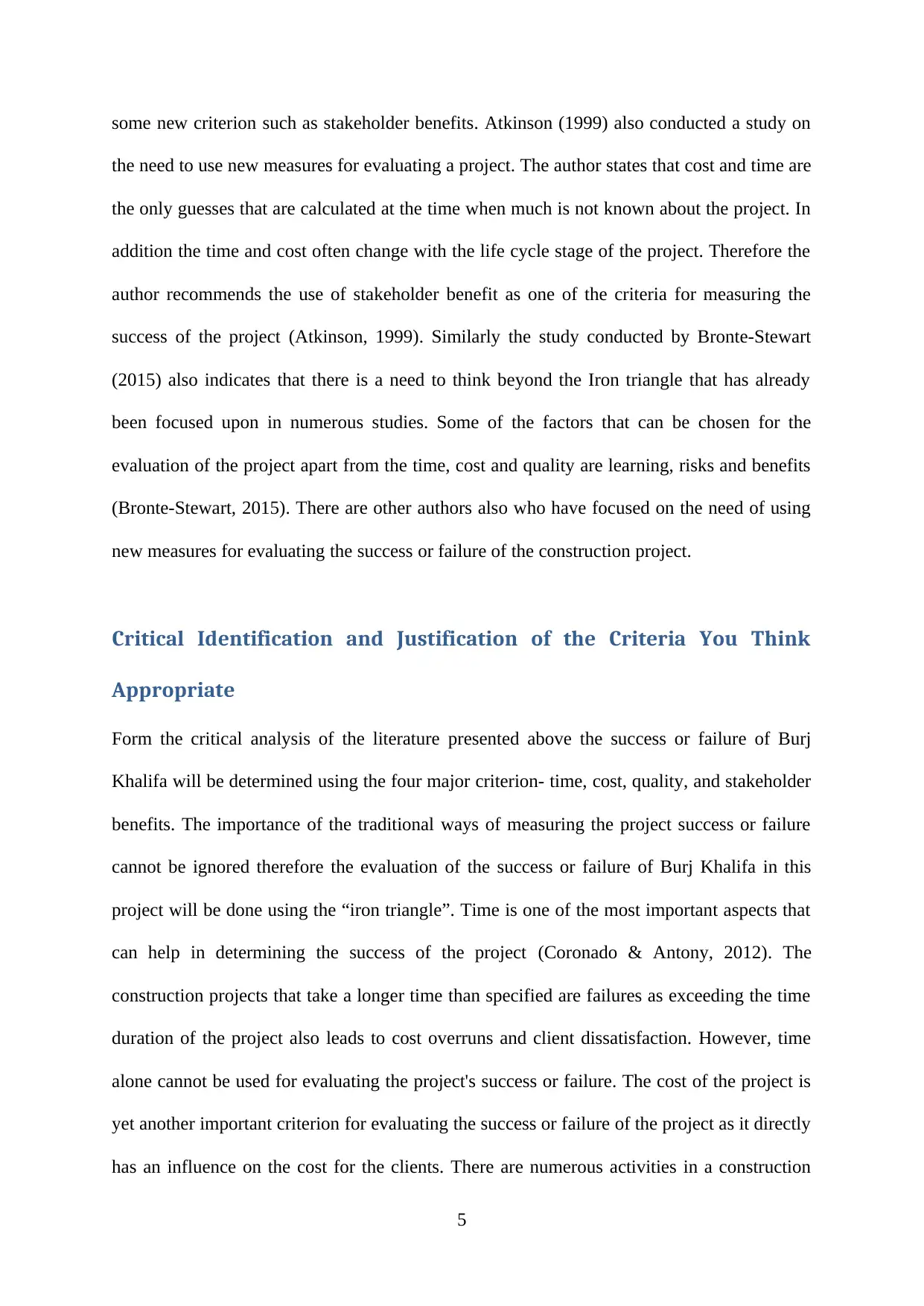
some new criterion such as stakeholder benefits. Atkinson (1999) also conducted a study on
the need to use new measures for evaluating a project. The author states that cost and time are
the only guesses that are calculated at the time when much is not known about the project. In
addition the time and cost often change with the life cycle stage of the project. Therefore the
author recommends the use of stakeholder benefit as one of the criteria for measuring the
success of the project (Atkinson, 1999). Similarly the study conducted by Bronte-Stewart
(2015) also indicates that there is a need to think beyond the Iron triangle that has already
been focused upon in numerous studies. Some of the factors that can be chosen for the
evaluation of the project apart from the time, cost and quality are learning, risks and benefits
(Bronte-Stewart, 2015). There are other authors also who have focused on the need of using
new measures for evaluating the success or failure of the construction project.
Critical Identification and Justification of the Criteria You Think
Appropriate
Form the critical analysis of the literature presented above the success or failure of Burj
Khalifa will be determined using the four major criterion- time, cost, quality, and stakeholder
benefits. The importance of the traditional ways of measuring the project success or failure
cannot be ignored therefore the evaluation of the success or failure of Burj Khalifa in this
project will be done using the “iron triangle”. Time is one of the most important aspects that
can help in determining the success of the project (Coronado & Antony, 2012). The
construction projects that take a longer time than specified are failures as exceeding the time
duration of the project also leads to cost overruns and client dissatisfaction. However, time
alone cannot be used for evaluating the project's success or failure. The cost of the project is
yet another important criterion for evaluating the success or failure of the project as it directly
has an influence on the cost for the clients. There are numerous activities in a construction
5
the need to use new measures for evaluating a project. The author states that cost and time are
the only guesses that are calculated at the time when much is not known about the project. In
addition the time and cost often change with the life cycle stage of the project. Therefore the
author recommends the use of stakeholder benefit as one of the criteria for measuring the
success of the project (Atkinson, 1999). Similarly the study conducted by Bronte-Stewart
(2015) also indicates that there is a need to think beyond the Iron triangle that has already
been focused upon in numerous studies. Some of the factors that can be chosen for the
evaluation of the project apart from the time, cost and quality are learning, risks and benefits
(Bronte-Stewart, 2015). There are other authors also who have focused on the need of using
new measures for evaluating the success or failure of the construction project.
Critical Identification and Justification of the Criteria You Think
Appropriate
Form the critical analysis of the literature presented above the success or failure of Burj
Khalifa will be determined using the four major criterion- time, cost, quality, and stakeholder
benefits. The importance of the traditional ways of measuring the project success or failure
cannot be ignored therefore the evaluation of the success or failure of Burj Khalifa in this
project will be done using the “iron triangle”. Time is one of the most important aspects that
can help in determining the success of the project (Coronado & Antony, 2012). The
construction projects that take a longer time than specified are failures as exceeding the time
duration of the project also leads to cost overruns and client dissatisfaction. However, time
alone cannot be used for evaluating the project's success or failure. The cost of the project is
yet another important criterion for evaluating the success or failure of the project as it directly
has an influence on the cost for the clients. There are numerous activities in a construction
5
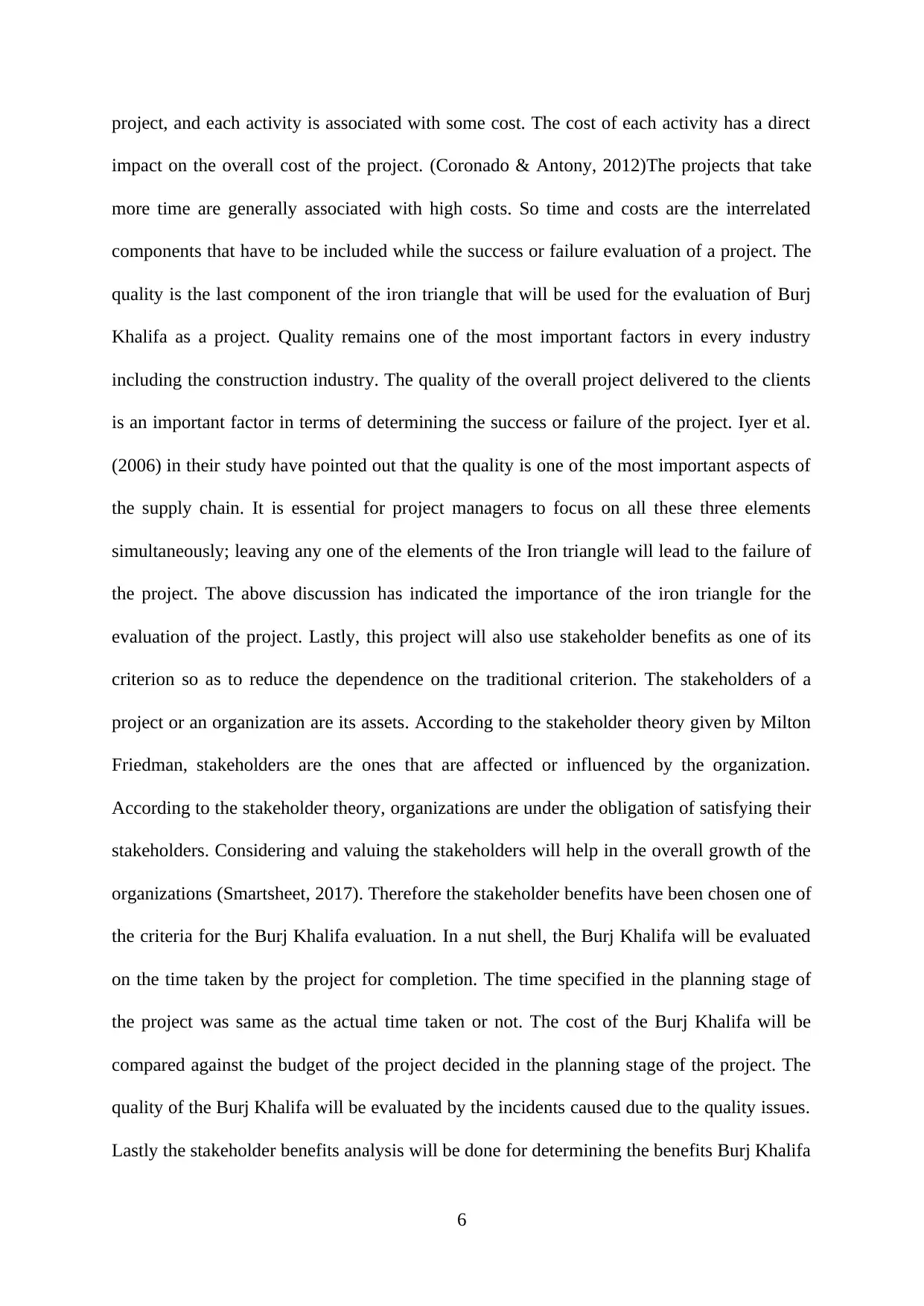
project, and each activity is associated with some cost. The cost of each activity has a direct
impact on the overall cost of the project. (Coronado & Antony, 2012)The projects that take
more time are generally associated with high costs. So time and costs are the interrelated
components that have to be included while the success or failure evaluation of a project. The
quality is the last component of the iron triangle that will be used for the evaluation of Burj
Khalifa as a project. Quality remains one of the most important factors in every industry
including the construction industry. The quality of the overall project delivered to the clients
is an important factor in terms of determining the success or failure of the project. Iyer et al.
(2006) in their study have pointed out that the quality is one of the most important aspects of
the supply chain. It is essential for project managers to focus on all these three elements
simultaneously; leaving any one of the elements of the Iron triangle will lead to the failure of
the project. The above discussion has indicated the importance of the iron triangle for the
evaluation of the project. Lastly, this project will also use stakeholder benefits as one of its
criterion so as to reduce the dependence on the traditional criterion. The stakeholders of a
project or an organization are its assets. According to the stakeholder theory given by Milton
Friedman, stakeholders are the ones that are affected or influenced by the organization.
According to the stakeholder theory, organizations are under the obligation of satisfying their
stakeholders. Considering and valuing the stakeholders will help in the overall growth of the
organizations (Smartsheet, 2017). Therefore the stakeholder benefits have been chosen one of
the criteria for the Burj Khalifa evaluation. In a nut shell, the Burj Khalifa will be evaluated
on the time taken by the project for completion. The time specified in the planning stage of
the project was same as the actual time taken or not. The cost of the Burj Khalifa will be
compared against the budget of the project decided in the planning stage of the project. The
quality of the Burj Khalifa will be evaluated by the incidents caused due to the quality issues.
Lastly the stakeholder benefits analysis will be done for determining the benefits Burj Khalifa
6
impact on the overall cost of the project. (Coronado & Antony, 2012)The projects that take
more time are generally associated with high costs. So time and costs are the interrelated
components that have to be included while the success or failure evaluation of a project. The
quality is the last component of the iron triangle that will be used for the evaluation of Burj
Khalifa as a project. Quality remains one of the most important factors in every industry
including the construction industry. The quality of the overall project delivered to the clients
is an important factor in terms of determining the success or failure of the project. Iyer et al.
(2006) in their study have pointed out that the quality is one of the most important aspects of
the supply chain. It is essential for project managers to focus on all these three elements
simultaneously; leaving any one of the elements of the Iron triangle will lead to the failure of
the project. The above discussion has indicated the importance of the iron triangle for the
evaluation of the project. Lastly, this project will also use stakeholder benefits as one of its
criterion so as to reduce the dependence on the traditional criterion. The stakeholders of a
project or an organization are its assets. According to the stakeholder theory given by Milton
Friedman, stakeholders are the ones that are affected or influenced by the organization.
According to the stakeholder theory, organizations are under the obligation of satisfying their
stakeholders. Considering and valuing the stakeholders will help in the overall growth of the
organizations (Smartsheet, 2017). Therefore the stakeholder benefits have been chosen one of
the criteria for the Burj Khalifa evaluation. In a nut shell, the Burj Khalifa will be evaluated
on the time taken by the project for completion. The time specified in the planning stage of
the project was same as the actual time taken or not. The cost of the Burj Khalifa will be
compared against the budget of the project decided in the planning stage of the project. The
quality of the Burj Khalifa will be evaluated by the incidents caused due to the quality issues.
Lastly the stakeholder benefits analysis will be done for determining the benefits Burj Khalifa
6
You're viewing a preview
Unlock full access by subscribing today!
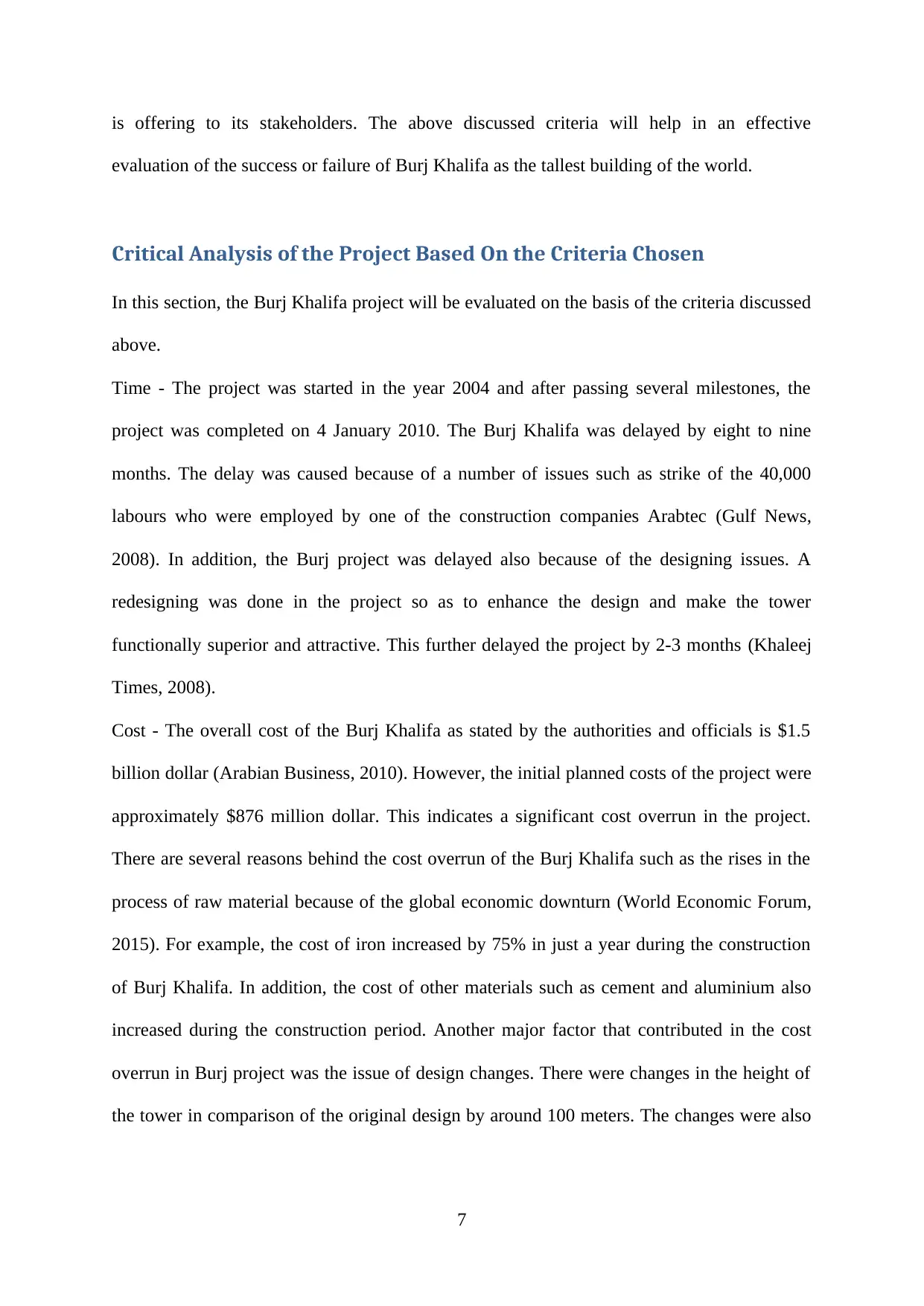
is offering to its stakeholders. The above discussed criteria will help in an effective
evaluation of the success or failure of Burj Khalifa as the tallest building of the world.
Critical Analysis of the Project Based On the Criteria Chosen
In this section, the Burj Khalifa project will be evaluated on the basis of the criteria discussed
above.
Time - The project was started in the year 2004 and after passing several milestones, the
project was completed on 4 January 2010. The Burj Khalifa was delayed by eight to nine
months. The delay was caused because of a number of issues such as strike of the 40,000
labours who were employed by one of the construction companies Arabtec (Gulf News,
2008). In addition, the Burj project was delayed also because of the designing issues. A
redesigning was done in the project so as to enhance the design and make the tower
functionally superior and attractive. This further delayed the project by 2-3 months (Khaleej
Times, 2008).
Cost - The overall cost of the Burj Khalifa as stated by the authorities and officials is $1.5
billion dollar (Arabian Business, 2010). However, the initial planned costs of the project were
approximately $876 million dollar. This indicates a significant cost overrun in the project.
There are several reasons behind the cost overrun of the Burj Khalifa such as the rises in the
process of raw material because of the global economic downturn (World Economic Forum,
2015). For example, the cost of iron increased by 75% in just a year during the construction
of Burj Khalifa. In addition, the cost of other materials such as cement and aluminium also
increased during the construction period. Another major factor that contributed in the cost
overrun in Burj project was the issue of design changes. There were changes in the height of
the tower in comparison of the original design by around 100 meters. The changes were also
7
evaluation of the success or failure of Burj Khalifa as the tallest building of the world.
Critical Analysis of the Project Based On the Criteria Chosen
In this section, the Burj Khalifa project will be evaluated on the basis of the criteria discussed
above.
Time - The project was started in the year 2004 and after passing several milestones, the
project was completed on 4 January 2010. The Burj Khalifa was delayed by eight to nine
months. The delay was caused because of a number of issues such as strike of the 40,000
labours who were employed by one of the construction companies Arabtec (Gulf News,
2008). In addition, the Burj project was delayed also because of the designing issues. A
redesigning was done in the project so as to enhance the design and make the tower
functionally superior and attractive. This further delayed the project by 2-3 months (Khaleej
Times, 2008).
Cost - The overall cost of the Burj Khalifa as stated by the authorities and officials is $1.5
billion dollar (Arabian Business, 2010). However, the initial planned costs of the project were
approximately $876 million dollar. This indicates a significant cost overrun in the project.
There are several reasons behind the cost overrun of the Burj Khalifa such as the rises in the
process of raw material because of the global economic downturn (World Economic Forum,
2015). For example, the cost of iron increased by 75% in just a year during the construction
of Burj Khalifa. In addition, the cost of other materials such as cement and aluminium also
increased during the construction period. Another major factor that contributed in the cost
overrun in Burj project was the issue of design changes. There were changes in the height of
the tower in comparison of the original design by around 100 meters. The changes were also
7
Paraphrase This Document
Need a fresh take? Get an instant paraphrase of this document with our AI Paraphraser
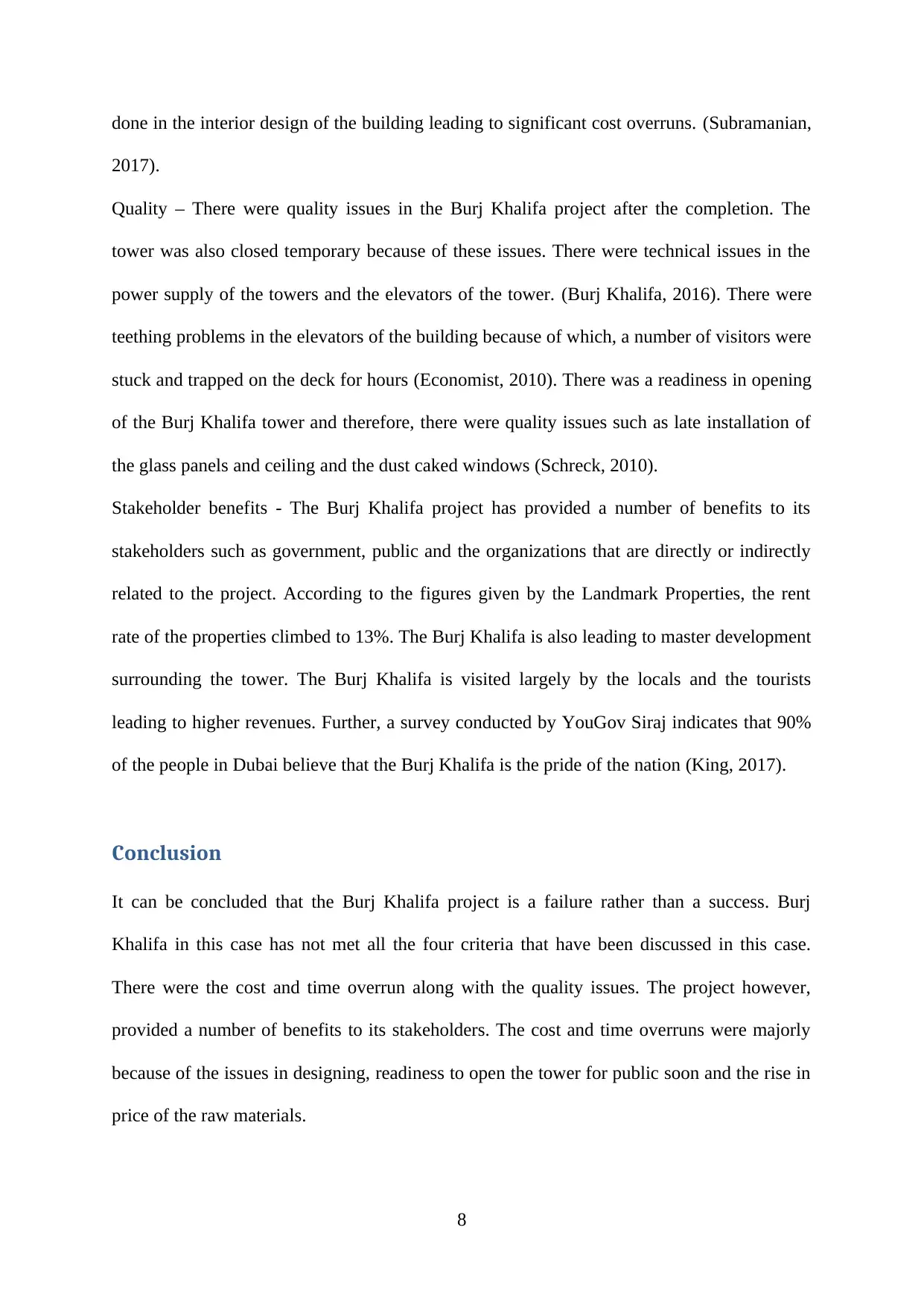
done in the interior design of the building leading to significant cost overruns. (Subramanian,
2017).
Quality – There were quality issues in the Burj Khalifa project after the completion. The
tower was also closed temporary because of these issues. There were technical issues in the
power supply of the towers and the elevators of the tower. (Burj Khalifa, 2016). There were
teething problems in the elevators of the building because of which, a number of visitors were
stuck and trapped on the deck for hours (Economist, 2010). There was a readiness in opening
of the Burj Khalifa tower and therefore, there were quality issues such as late installation of
the glass panels and ceiling and the dust caked windows (Schreck, 2010).
Stakeholder benefits - The Burj Khalifa project has provided a number of benefits to its
stakeholders such as government, public and the organizations that are directly or indirectly
related to the project. According to the figures given by the Landmark Properties, the rent
rate of the properties climbed to 13%. The Burj Khalifa is also leading to master development
surrounding the tower. The Burj Khalifa is visited largely by the locals and the tourists
leading to higher revenues. Further, a survey conducted by YouGov Siraj indicates that 90%
of the people in Dubai believe that the Burj Khalifa is the pride of the nation (King, 2017).
Conclusion
It can be concluded that the Burj Khalifa project is a failure rather than a success. Burj
Khalifa in this case has not met all the four criteria that have been discussed in this case.
There were the cost and time overrun along with the quality issues. The project however,
provided a number of benefits to its stakeholders. The cost and time overruns were majorly
because of the issues in designing, readiness to open the tower for public soon and the rise in
price of the raw materials.
8
2017).
Quality – There were quality issues in the Burj Khalifa project after the completion. The
tower was also closed temporary because of these issues. There were technical issues in the
power supply of the towers and the elevators of the tower. (Burj Khalifa, 2016). There were
teething problems in the elevators of the building because of which, a number of visitors were
stuck and trapped on the deck for hours (Economist, 2010). There was a readiness in opening
of the Burj Khalifa tower and therefore, there were quality issues such as late installation of
the glass panels and ceiling and the dust caked windows (Schreck, 2010).
Stakeholder benefits - The Burj Khalifa project has provided a number of benefits to its
stakeholders such as government, public and the organizations that are directly or indirectly
related to the project. According to the figures given by the Landmark Properties, the rent
rate of the properties climbed to 13%. The Burj Khalifa is also leading to master development
surrounding the tower. The Burj Khalifa is visited largely by the locals and the tourists
leading to higher revenues. Further, a survey conducted by YouGov Siraj indicates that 90%
of the people in Dubai believe that the Burj Khalifa is the pride of the nation (King, 2017).
Conclusion
It can be concluded that the Burj Khalifa project is a failure rather than a success. Burj
Khalifa in this case has not met all the four criteria that have been discussed in this case.
There were the cost and time overrun along with the quality issues. The project however,
provided a number of benefits to its stakeholders. The cost and time overruns were majorly
because of the issues in designing, readiness to open the tower for public soon and the rise in
price of the raw materials.
8
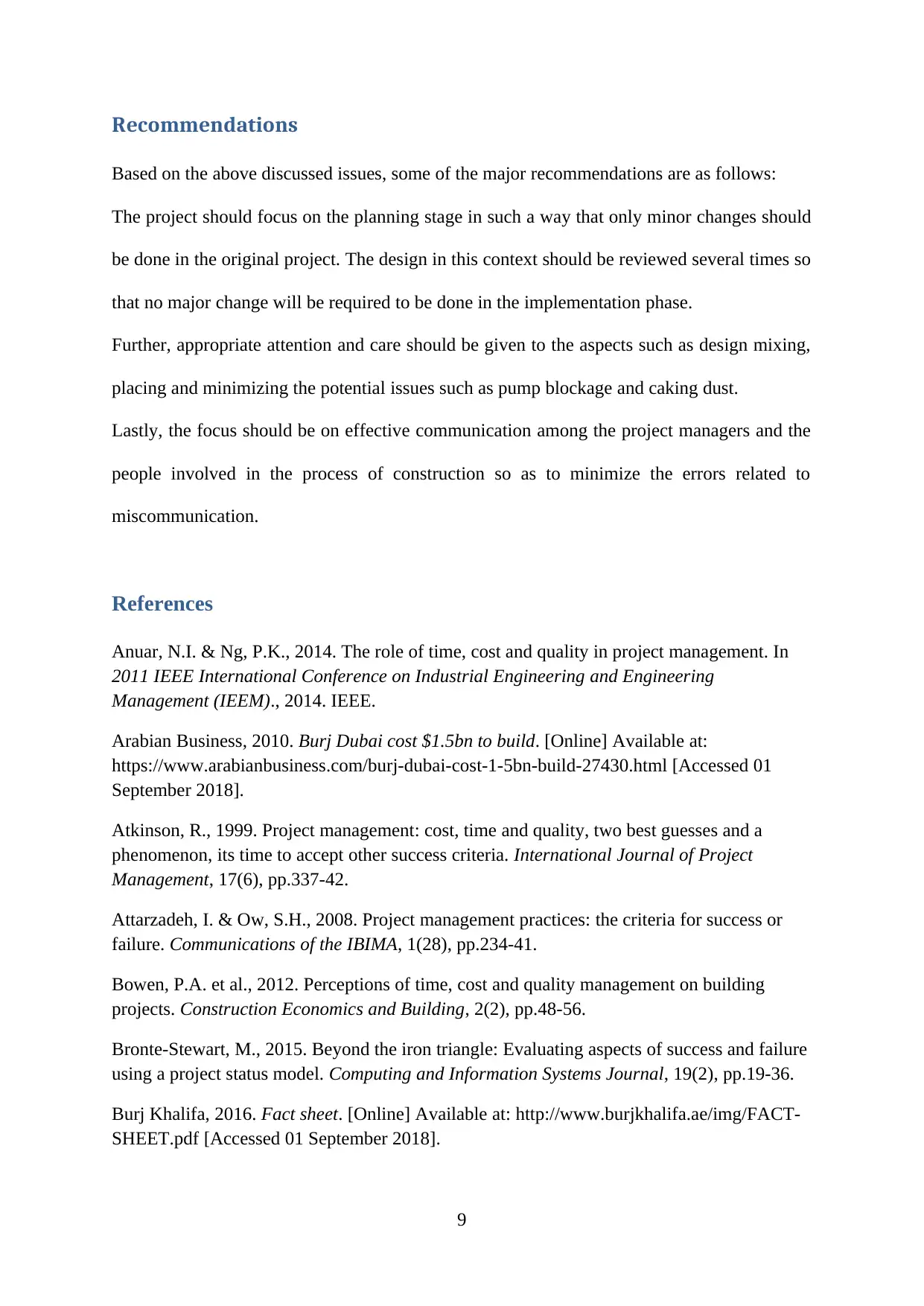
Recommendations
Based on the above discussed issues, some of the major recommendations are as follows:
The project should focus on the planning stage in such a way that only minor changes should
be done in the original project. The design in this context should be reviewed several times so
that no major change will be required to be done in the implementation phase.
Further, appropriate attention and care should be given to the aspects such as design mixing,
placing and minimizing the potential issues such as pump blockage and caking dust.
Lastly, the focus should be on effective communication among the project managers and the
people involved in the process of construction so as to minimize the errors related to
miscommunication.
References
Anuar, N.I. & Ng, P.K., 2014. The role of time, cost and quality in project management. In
2011 IEEE International Conference on Industrial Engineering and Engineering
Management (IEEM)., 2014. IEEE.
Arabian Business, 2010. Burj Dubai cost $1.5bn to build. [Online] Available at:
https://www.arabianbusiness.com/burj-dubai-cost-1-5bn-build-27430.html [Accessed 01
September 2018].
Atkinson, R., 1999. Project management: cost, time and quality, two best guesses and a
phenomenon, its time to accept other success criteria. International Journal of Project
Management, 17(6), pp.337-42.
Attarzadeh, I. & Ow, S.H., 2008. Project management practices: the criteria for success or
failure. Communications of the IBIMA, 1(28), pp.234-41.
Bowen, P.A. et al., 2012. Perceptions of time, cost and quality management on building
projects. Construction Economics and Building, 2(2), pp.48-56.
Bronte-Stewart, M., 2015. Beyond the iron triangle: Evaluating aspects of success and failure
using a project status model. Computing and Information Systems Journal, 19(2), pp.19-36.
Burj Khalifa, 2016. Fact sheet. [Online] Available at: http://www.burjkhalifa.ae/img/FACT-
SHEET.pdf [Accessed 01 September 2018].
9
Based on the above discussed issues, some of the major recommendations are as follows:
The project should focus on the planning stage in such a way that only minor changes should
be done in the original project. The design in this context should be reviewed several times so
that no major change will be required to be done in the implementation phase.
Further, appropriate attention and care should be given to the aspects such as design mixing,
placing and minimizing the potential issues such as pump blockage and caking dust.
Lastly, the focus should be on effective communication among the project managers and the
people involved in the process of construction so as to minimize the errors related to
miscommunication.
References
Anuar, N.I. & Ng, P.K., 2014. The role of time, cost and quality in project management. In
2011 IEEE International Conference on Industrial Engineering and Engineering
Management (IEEM)., 2014. IEEE.
Arabian Business, 2010. Burj Dubai cost $1.5bn to build. [Online] Available at:
https://www.arabianbusiness.com/burj-dubai-cost-1-5bn-build-27430.html [Accessed 01
September 2018].
Atkinson, R., 1999. Project management: cost, time and quality, two best guesses and a
phenomenon, its time to accept other success criteria. International Journal of Project
Management, 17(6), pp.337-42.
Attarzadeh, I. & Ow, S.H., 2008. Project management practices: the criteria for success or
failure. Communications of the IBIMA, 1(28), pp.234-41.
Bowen, P.A. et al., 2012. Perceptions of time, cost and quality management on building
projects. Construction Economics and Building, 2(2), pp.48-56.
Bronte-Stewart, M., 2015. Beyond the iron triangle: Evaluating aspects of success and failure
using a project status model. Computing and Information Systems Journal, 19(2), pp.19-36.
Burj Khalifa, 2016. Fact sheet. [Online] Available at: http://www.burjkhalifa.ae/img/FACT-
SHEET.pdf [Accessed 01 September 2018].
9
You're viewing a preview
Unlock full access by subscribing today!
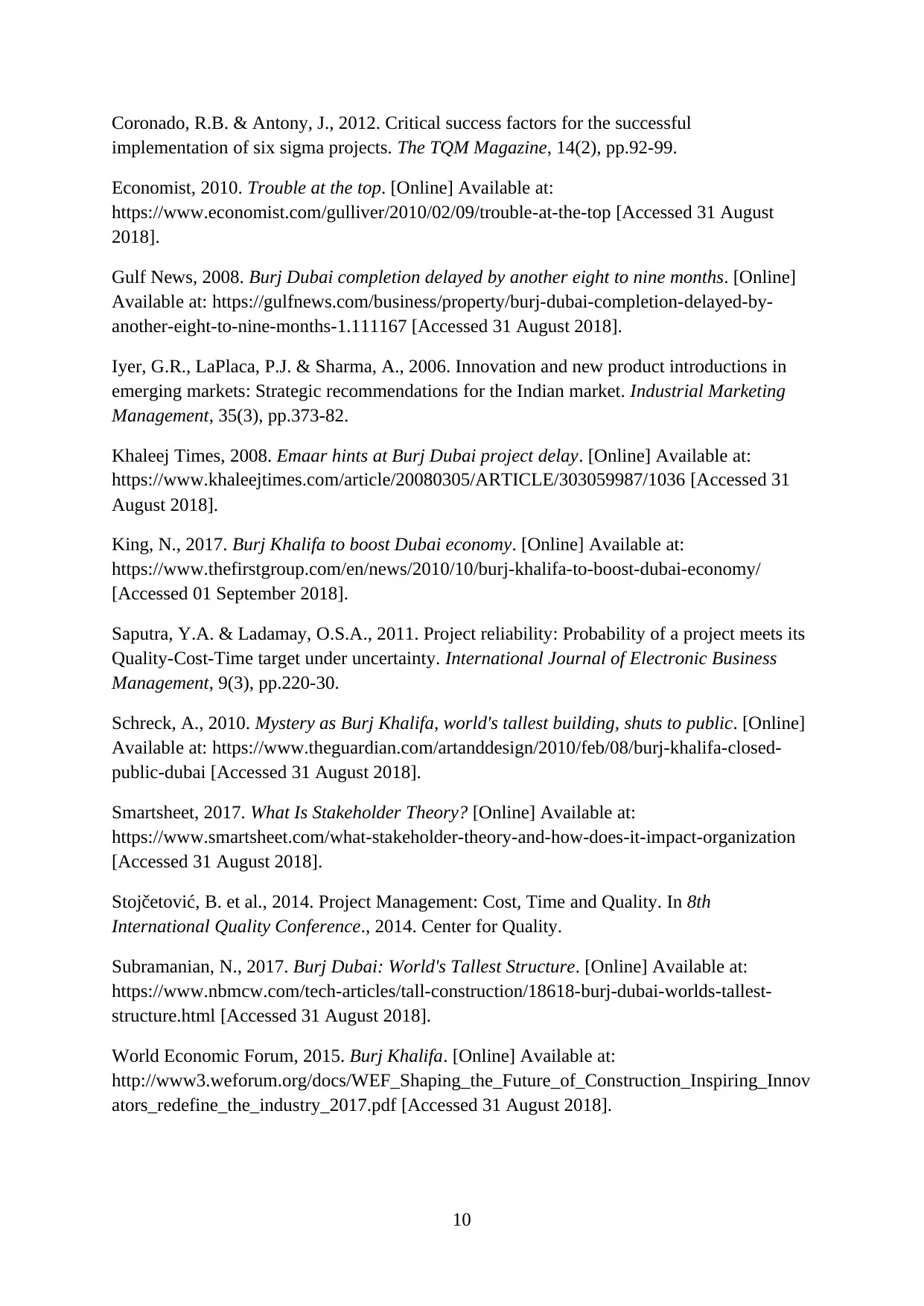
Coronado, R.B. & Antony, J., 2012. Critical success factors for the successful
implementation of six sigma projects. The TQM Magazine, 14(2), pp.92-99.
Economist, 2010. Trouble at the top. [Online] Available at:
https://www.economist.com/gulliver/2010/02/09/trouble-at-the-top [Accessed 31 August
2018].
Gulf News, 2008. Burj Dubai completion delayed by another eight to nine months. [Online]
Available at: https://gulfnews.com/business/property/burj-dubai-completion-delayed-by-
another-eight-to-nine-months-1.111167 [Accessed 31 August 2018].
Iyer, G.R., LaPlaca, P.J. & Sharma, A., 2006. Innovation and new product introductions in
emerging markets: Strategic recommendations for the Indian market. Industrial Marketing
Management, 35(3), pp.373-82.
Khaleej Times, 2008. Emaar hints at Burj Dubai project delay. [Online] Available at:
https://www.khaleejtimes.com/article/20080305/ARTICLE/303059987/1036 [Accessed 31
August 2018].
King, N., 2017. Burj Khalifa to boost Dubai economy. [Online] Available at:
https://www.thefirstgroup.com/en/news/2010/10/burj-khalifa-to-boost-dubai-economy/
[Accessed 01 September 2018].
Saputra, Y.A. & Ladamay, O.S.A., 2011. Project reliability: Probability of a project meets its
Quality-Cost-Time target under uncertainty. International Journal of Electronic Business
Management, 9(3), pp.220-30.
Schreck, A., 2010. Mystery as Burj Khalifa, world's tallest building, shuts to public. [Online]
Available at: https://www.theguardian.com/artanddesign/2010/feb/08/burj-khalifa-closed-
public-dubai [Accessed 31 August 2018].
Smartsheet, 2017. What Is Stakeholder Theory? [Online] Available at:
https://www.smartsheet.com/what-stakeholder-theory-and-how-does-it-impact-organization
[Accessed 31 August 2018].
Stojčetović, B. et al., 2014. Project Management: Cost, Time and Quality. In 8th
International Quality Conference., 2014. Center for Quality.
Subramanian, N., 2017. Burj Dubai: World's Tallest Structure. [Online] Available at:
https://www.nbmcw.com/tech-articles/tall-construction/18618-burj-dubai-worlds-tallest-
structure.html [Accessed 31 August 2018].
World Economic Forum, 2015. Burj Khalifa. [Online] Available at:
http://www3.weforum.org/docs/WEF_Shaping_the_Future_of_Construction_Inspiring_Innov
ators_redefine_the_industry_2017.pdf [Accessed 31 August 2018].
10
implementation of six sigma projects. The TQM Magazine, 14(2), pp.92-99.
Economist, 2010. Trouble at the top. [Online] Available at:
https://www.economist.com/gulliver/2010/02/09/trouble-at-the-top [Accessed 31 August
2018].
Gulf News, 2008. Burj Dubai completion delayed by another eight to nine months. [Online]
Available at: https://gulfnews.com/business/property/burj-dubai-completion-delayed-by-
another-eight-to-nine-months-1.111167 [Accessed 31 August 2018].
Iyer, G.R., LaPlaca, P.J. & Sharma, A., 2006. Innovation and new product introductions in
emerging markets: Strategic recommendations for the Indian market. Industrial Marketing
Management, 35(3), pp.373-82.
Khaleej Times, 2008. Emaar hints at Burj Dubai project delay. [Online] Available at:
https://www.khaleejtimes.com/article/20080305/ARTICLE/303059987/1036 [Accessed 31
August 2018].
King, N., 2017. Burj Khalifa to boost Dubai economy. [Online] Available at:
https://www.thefirstgroup.com/en/news/2010/10/burj-khalifa-to-boost-dubai-economy/
[Accessed 01 September 2018].
Saputra, Y.A. & Ladamay, O.S.A., 2011. Project reliability: Probability of a project meets its
Quality-Cost-Time target under uncertainty. International Journal of Electronic Business
Management, 9(3), pp.220-30.
Schreck, A., 2010. Mystery as Burj Khalifa, world's tallest building, shuts to public. [Online]
Available at: https://www.theguardian.com/artanddesign/2010/feb/08/burj-khalifa-closed-
public-dubai [Accessed 31 August 2018].
Smartsheet, 2017. What Is Stakeholder Theory? [Online] Available at:
https://www.smartsheet.com/what-stakeholder-theory-and-how-does-it-impact-organization
[Accessed 31 August 2018].
Stojčetović, B. et al., 2014. Project Management: Cost, Time and Quality. In 8th
International Quality Conference., 2014. Center for Quality.
Subramanian, N., 2017. Burj Dubai: World's Tallest Structure. [Online] Available at:
https://www.nbmcw.com/tech-articles/tall-construction/18618-burj-dubai-worlds-tallest-
structure.html [Accessed 31 August 2018].
World Economic Forum, 2015. Burj Khalifa. [Online] Available at:
http://www3.weforum.org/docs/WEF_Shaping_the_Future_of_Construction_Inspiring_Innov
ators_redefine_the_industry_2017.pdf [Accessed 31 August 2018].
10
1 out of 10
Related Documents
Your All-in-One AI-Powered Toolkit for Academic Success.
+13062052269
info@desklib.com
Available 24*7 on WhatsApp / Email
![[object Object]](/_next/static/media/star-bottom.7253800d.svg)
Unlock your academic potential
© 2024 | Zucol Services PVT LTD | All rights reserved.





